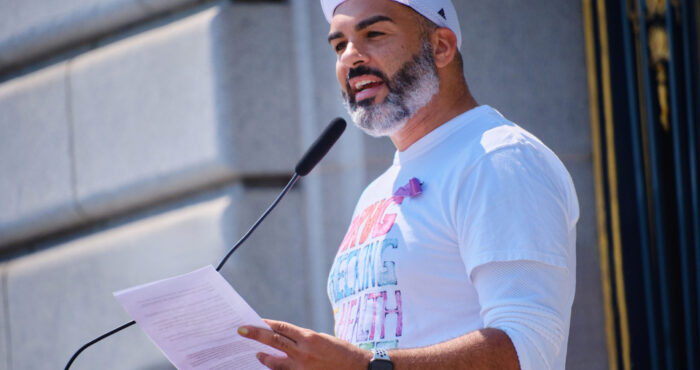Expanded ADAP Coverage: A Win for Californians

On June 29, 2024, Governor Newsom signed the state budget for fiscal year 2024-25, which includes significant expansions to the state’s AIDS Drug Assistance Program (ADAP) and associated services. We spoke with Anne Donnelly, State Healthcare Policy Director at San Francisco AIDS Foundation, to help explain these changes.
What are the changes?
Effective January 1, 2025, there will be some key changes to ADAP:
- Increased Financial Eligibility: More people will qualify for ADAP and PrEP-AP, and these changes will be especially relevant to seniors and people who are married to HIV-negative partners. The financial eligibility will rise from 500% of the federal poverty level to 600% (which may be around $90,000 for a household of one, or $122,000 for a household of two people).
- Higher Health Insurance Premium Payment (HIPP) Program Cap: The monthly cap on healthcare premium payment assistance will increase from $1,938 to $2,996, which will help reduce financial burdens and ensure timely care.
- Open Formulary (no limits on access to medications): The ADAP formulary will be modified to an open formulary, allowing for more individualized and timely access to necessary medications. This will be particularly beneficial to people who are growing older, and people who have other health conditions. This could also be an important change for people who may need a drug that is related to their HIV but not already in the formulary.
Why is this expanded coverage important?
This expansion is a crucial victory achieved through the dedicated efforts of the California Ending the Epidemics Coalition (EtE) and the San Francisco AIDS Foundation (SFAF) policy team. The California State Legislature, particularly the LGBTQ+ caucus, played a key role in championing the budget request. Despite a challenging budget deficit, we secured vital enhancements that will improve healthcare access and outcomes for Californians living with or vulnerable to HIV.
The expanded coverage is essential in maintaining and improving the quality of HIV prevention and treatment services amidst financial challenges.
In addition, we also secured a win to guarantee the ability of the ADAP to evolve and expand in future years. Because the state borrowed funds from the ADAP Rebate Fund, it was crucial that we were able to secure a commitment that the state will repay and prioritize these funds for ADAP and related services. This payback language helps to ensure that the program will be able to adapt in the future, even in times of fiscal difficulty.
What did the SFAF Policy Team and End the Epidemics (EtE) coalition do to expand coverage?
Our years of experience and established connections enabled us to navigate the complex budgetary landscape effectively. The EtE coalition, through its community engagement and advocacy efforts, played a pivotal role. A notable achievement was the Day of Action, which brought together diverse voices to influence legislative decision-making. The collective effort ensured that the needs and stories of those directly impacted were heard, resulting in the best possible outcome.
A big thank you to our community members and community partners who came out to support our Day of Action this year!

What are the other expansions to the program ?
Also effective July 1, 2024, these programs and services that were a part of the EtE budget request will receive funding:
- The Harm Reduction Clearinghouse will receive $10 million annually for three years to fund HIV prevention supplies for syringe access programs.
- The Transgender, Gender Nonconforming, and Intersex (TGI) Services will receive $5 million annually for three years to support care and treatment services for people affected by HIV.
- PrEP and ADAP Services Analysis: A total of $200,000 in one-time funding will help to support the assessment and delivery of PrEP-AP and ADAP navigation and retention services.
- Condom Access in Schools: A total of $5 million will go to fund condom access for pupils in grades 9-12 in public schools, contingent on the passage of SB 954.
In addition, EtE and SFAF supported the changes that were included in the Governor’s original 2024/25 budget proposal. These programs and services will be effective July 1, 2024.
- Client Navigation Outreach program will provide outreach and navigation services for ADAP clients who are not enrolled in comprehensive health insurance coverage
- Medicare Premium Payment Program (MIPP) will expand to cover Dental and Vision. Currently, the HIPP covers dental and vision insurance but once a person becomes eligible for Medicare they no longer receive that assistance. Extending the same level of premium assistance from the HIPP program to MPPP ensures consistent health coverage and protect seniors who often have higher health care costs.
- MIPP will cover the Medicare Part D (prescription drug) plan of choice for all clients. Currently low income Medicare clients have to use a Part D “benchmark” plan in order to get their premium fully subsidized by Medicare. They also can’t qualify for the MIPP because their premium is already fully paid. However, the “benchmark” plans typically have more restrictive formularies and the numbers of benchmark plans are dramatically decreasing leading to very limited choices. This will allow clients a wider range of choice and coverage leading to better health outcomes.
- Expanding the ADAP Pilot Program for Jails. Prior to 2008, ADAP provided medication to qualifying folks. In 2008, the funding was eliminated during a budget deficit. The State Office of AIDS initiated a pilot project that serves 6 counties. This expansion could serve the additional four counties that have expressed interest.
How can people find out more?
Changes to ADAP and PrEP-AP will be communicated to enrollment workers as more information becomes available.
If you don’t have an enrollment worker currently, the ADAP Enrollment Site Locator can be used to find a local ADAP enrollment site. The PrEP-AP Provider & Enrollment Site Map can be used to find a PrEP-AP Enrollment Site and/or a PrEP-AP Clinical Provider.









